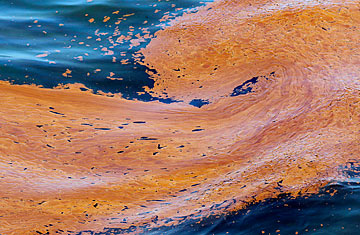
Oil blobs and oil sheen are seen in the waters of Chandeleur Sound, La., Tuesday, May 4, 2010.
One of the factors that makes the Deepwater Horizon accident different — and worse — than the average oil spill is that it really isn't a spill at all. From the beginning, BP and the Coast Guard have had to fight a war on two fronts: at the surface, fortifying the Gulf coastline against the oncoming oil and containing the slick, and 5,000 feet below on the seabed, where robot submarines are working to cap the broken well and staunch the flow of oil. "In a normal spill you'd know how much oil was in the tanker, so you'd know the quantity being lost, down to the barrel," says Malcolm Spaulding, a professor of ocean engineering at the University of Rhode Island. "But here they don't have control over the source."
On Tuesday BP was able to report some long-awaited good news, at least on one front. The company had managed to install a valve over the end of a broken drill pipe on the sea floor, cutting the flow of oil from one of the three leaks bleeding into the Gulf. It was the first concrete success BP has had in dealing with the wreck, but it's unlikely to actually reduce the amount of oil leaking out, now estimated to be 210,000 gallons a day, and possibly much more.
The next chance began Wednesday, when the company hauled a massive containment dome toward the site of the wreck. There, it will be lowered over the leak to corral the escaping oil, and allow it to be pumped to a drill ship on the surface. That should pull up about 125,000 barrels of oil, but it won't be easy. The key challenge is simple depth — working at 5,000 feet under is akin to working in space, except space has better weather than the Gulf of Mexico. "This has never been done in 5,000 feet of water...so we'll undoubtedly encounter some issues as we go through that process," BP CEO Tony Hayward told reporters at a news conference. A good outcome would "have the principal leak contained by the early part of next week. But there's no guarantees."
Congressional representatives briefed by BP executives on Tuesday said that if the containment domes failed to work, the oil leaking from the well could surge to as much as 60,000 barrels, or 2.5 million gallons, a day. The only other option to stop the flow is a relief well that could be used tap into the first well and seal it with heavy liquid. That effort is already underway, and it's worked before in similar situations, but it would likely take at least 90 days, during which the oil would keep bleeding. "[BP] indicated to us that they do believe they have a possibility of being successful, but they are not guaranteed," Democratic Congressman Edward Markey told reporters. "It's pretty clear there was not a proper preparation for the worst-case scenario."
Setbacks on the sea floor have put more pressure on the other front of BP's war — fighting the oil on the surface. The chief weapons right now are dispersants, chemicals that can be applied to the surface of the oil slick, breaking down the petroleum and speeding up the natural process of evaporation and decomposition.
Crews battling the spill have already dropped more than 150,000 gallons of dispersants on the oil, and BP has begun applying dispersants directly to the underwater leaks — something that's never been tried before. "We hope that can be an effective tool," said Doug Suttles, BP's chief operating officer.
The company is also employing a technique called "in-situ" burning, corralling the oil slick with metal fire booms at the surface. Once the fire booms — essentially, floating, fireproof barriers — have gathered the oil into a thick enough slick, it can be set aflame, burning off the petroleum from the water. (Without the booms, an open oil slick would spread too thinly on the surface to sustain a fire.) BP was able to burn off thousands of gallons of oil successfully on April 28, but fierce winds made a repeat operation impossible until Wednesday, when the company planned another controlled fire. "We're going to engage in burning" if the oil reaches Mississippi, the state's governor Haley Barbour told TIME. "We do not take for granted that this is going to be catastrophic."
But even if these techniques help blunt the impact of the oil on the shoreline, they aren't free of side effects. The exact makeup of dispersants is a trade secret, but the chemicals are known to be toxic to marine creatures — especially life in the open water. And while most environmentalists are in favor of using dispersants to protect animals onshore — the chemical is a standard tool for oil spill response — no one really knows what will happen when the dispersants are applied in the deep water.
While dispersed oil is more easily cleaned up, it can also collect on the seabed, where it can infiltrate the bottom of the food chain. The evaporation process, which is encouraged by dispersants, can also leave behind more concentrated toxic compounds, such as polycyclic aromatic hydrocarbons. "We don't really know much about what dispersants might do here," says Nancy Kinner, co-director of the Coastal Response Research Center at the University of New Hampshire. "The thing to understand is that everything being tried now is a tradeoff." As the anxious residents of the Gulf Coast wait for the oil slick — being held back for now by currents and the wind — to make landfall, it's a tradeoff that could easily turn for the worse.
